Research on the Policy Analysis of Sustainable Energy Based on Policy Knowledge Graph Technology—A Case Study in China
Abstract
:1. Introduction
2. Materials and Methods
2.1. Data Source and Preprocessing
2.2. Construction of Policy Knowledge Graph
2.2.1. Concept Layer Construction Based on Domain Ontology
2.2.2. Policy Entity Extraction and Relationship Construction
2.2.3. Knowledge Fusion
2.3. Graph Calculation Method
2.3.1. Degree Centrality
2.3.2. Betweenness Centrality
2.3.3. Closeness Centrality
2.3.4. PageRank Algorithm
2.3.5. Louvain Algorithm
3. Results and Discussion
3.1. Analysis of Policy Evolution
3.2. Analysis on the Coevolution of Jointly Issuing Departments and Powers
3.2.1. Analysis of Departmental Evolution
3.2.2. Analysis on the Coevolution of Departmental Power
3.3. Discussion
4. Conclusions and Policy Implications
4.1. Conclusions
4.2. Policy Implications
Author Contributions
Funding
Data Availability Statement
Acknowledgments
Conflicts of Interest
Appendix A
| Year | Department Number | Department Name | Cluster |
|---|---|---|---|
| 1990 | Cluster 1: {‘D0097’, ‘D0003’, ‘D0096’} Cluster 2: {‘D0972’, ‘D0004’, ‘D0337’, ‘D0077’, ‘D0007’} Cluster 3: {‘D0040’, ‘D1002’} Cluster 4: {‘D1493’,’D0357’} | Cluster 1: {Ministry of Water Resources and Electricity (changed), Ministry of Water Resources, and Ministry of Energy (changed)} Cluster 2: {The Agricultural Bank of China, Treasury Department, People’s Bank of China, Ministry of Construction (cancelled), and State Environmental Protection Administration (revoked)} Cluster 3: {The State Council, and Central Military Commission} Cluster 4: {National Economic Commission (changed), and State Price Bureau (changed)} | 4 |
| 1995 | Cluster 1: {‘D0007’, ‘D0004’, ‘D0077’, ‘D1494’, ‘‘D0357’, ‘D0002’, ‘D1499’, ‘D1493’} Cluster 2: {‘D0097’, ‘D0003’, ‘D0096’} Cluster 3: {‘D0337’, ‘D0972’} Cluster 4: {‘D0040’, ‘D1002’} Cluster 5: {‘D0211’, ‘D1497’} | Cluster 1: {State Environmental Protection Administration (revoked), Treasury Department, Ministry of Construction (cancelled), National Family Planning Commission (renamed), State Price Bureau (changed), National Development and Reform Commission (including the former National Development Planning Commission and the former National Planning Commission), Economic and Trade Office of the State Council (changed), and National Economic Commission (changed)} Cluster 2: {Ministry of Water Resources and Electricity (changed),Ministry of Water Resources, Ministry of Energy (changed)} Cluster 3: {People’s Bank of China, The Agricultural Bank of China} Cluster 4: {The State Council, Central Military Commission} Cluster 5: {National Economic and Trade Commission (changed), National Science and Technology Commission (changed)} | 5 |
| 2000 | Cluster 1: {‘D0077’, ‘D0061’, ‘D0004’, ‘D0979’, ‘D1497’, ‘D0211’, ‘D0002’, ‘D0007’, ‘D0072’} Cluster 2: {‘D0003’, ‘D0096’, ‘D0087’, ‘D0542’, ‘D0097’, ‘D0557’} Cluster 3: {‘D1494’, ‘D1499’, ‘D1493’, ‘D0357’} Cluster 4: {‘D0040’, ‘D1002’} Cluster 5: {‘D0972’, ‘D0337’} | Cluster 1: {Ministry of Construction (cancelled), State Administration of Taxation, Treasury Department, Ministry of Labor and Social Security (including the Ministry of Labor) (revoked), National Science and Technology Commission (changed), National Economic and Trade Commission (changed), National Development and Reform Commission (including the former National Development Planning Commission and the former National Planning Commission), State Environmental Protection Administration (revoked), and Department of Science and Technology} Cluster 2: {Ministry of Water Resources, Ministry of Energy (changed), Ministry of Electric Power Industry (changed), State Power Corporation, Ministry of Water Resources and Electricity (changed), and State Administration for Industry and Commerce (revoked)} Cluster 3: {National Family Planning Commission (renamed), Economic and Trade Office of the State Council (changed), National Economic Commission (changed), State Price Bureau (changed)} Cluster 4: {The State Council, and Central Military Commission} Cluster 5: {The Agricultural Bank of China, and People’s Bank of China} | 5 |
| 2005 | Cluster 1: {‘D0097’ ‘D0003’, ‘D0456’, ‘D0557’, ‘D0096’, ‘D0077’, ‘D0087’, ‘D0542’} Cluster 2: {‘D0061’, ‘D0004’, ‘D1494’, ‘D0357’, ‘D0979’, ‘D1499’, ‘D1493’} Cluster 3: {‘D0072’, ‘D0002’, ‘D1497’} Cluster 4: {‘D0211’, ‘D0007’} Cluster 5: {‘D0028’, ‘D0121’} Cluster 6: {‘D0337’, ‘D0972’} Cluster 7: {‘D1002’, ‘D0040’} | Cluster 1: {Ministry of Water Resources and Electricity (changed), Ministry of Water Resources, Personnel Department (cancelled), State Administration for Industry and Commerce (revoked), Ministry of Energy (changed), Ministry of Construction (cancelled), Ministry of Electric Power Industry (changed), and State Power Corporation} Cluster 2: {State Administration of Taxation, Treasury Department, National Family Planning Commission (renamed), State Price Bureau (changed), Ministry of Labor and Social Security (including the Ministry of Labor) (revoked), Economic and Trade Office of the State Council (changed), and National Economic Commission (changed)} Cluster 3: {Department of Science and Technology, National Development and Reform Commission (including the former National Development Planning Commission and the former National Planning Commission), and National Science and Technology Commission (changed)} Cluster 4: {National Economic and Trade Commission (changed), and State Environmental Protection Administration (revoked)} Cluster 5: {State Environmental Protection Administration (including the State Environmental Protection Administration) (revoked), and Ministry of Land and Resources (revoked)} Cluster 6: {People’s Bank of China, and The Agricultural Bank of China} Cluster 7: {Central Military Commission, and The State Council} | 7 |
| 2010 | Cluster 1: {‘D0298’ ‘D0243’, ‘D0621’, ‘D0133’, ‘D0002’, ‘D1512’, ‘D1355’, ‘D0049’, ‘D0015’} Cluster 2: {‘D0097’, ‘D0976’, ‘D0003’, ‘D0557’, ‘D0096’, ‘D0972’, ‘D0087’, ‘D0542’, ‘D1503’} Cluster 3: {‘D0004’, ‘D0102’, ‘D0079’, ‘D0012’, ‘D0979’} Cluster 4: {‘D0211’, ‘D0337’, ‘D0007’, ‘D1497’} Cluster 5: {‘D0077’, ‘D0456’, ‘D0879’} Cluster 6: {‘D1494’, ‘D0357’, ‘D1499’, ‘D1493’} Cluster 7: {‘D0028’, ‘D0587’, ‘D0121’} Cluster 8: {‘D0072’, ‘D0001’} Cluster 9: {‘D1002’, ‘D0040’} Cluster 10: {‘D0025’, ‘D0061’} Cluster 11: {‘D0091’, ‘D0115’} | Cluster 1: {Ministry of Health (revoked), Customs Head Office, National Women’s Federation, Ministry of Education of the People’s Republic of China, National Development and Reform Commission (including the former National Development Planning Commission and the former National Planning Commission), Office of the Central Steering Committee for the Construction of Spiritual Civilization, State Administration of Traditional Chinese Medicine, State Electricity Regulatory Commission (revoked), and Ministry of Environmental Protection (withdrawn)} Cluster 2: {Ministry of Water Resources and Electricity (changed), State Administration of Work Safety (former State Administration of Work Safety) (revoked), Ministry of Water Resources, State Administration for Industry and Commerce (revoked), Ministry of Energy (changed), The Agricultural Bank of China, Ministry of Electric Power Industry (changed), State Power Corporation, and State Administration of Coal Mine Safety} Cluster 3: {Treasury Department, State Oceanic Administration (revoked), Ministry of Industry and Information Technology, Ministry of Housing and Urban-Rural Development, and Ministry of Labor and Social Security (including the Ministry of Labor) (revoked)} Cluster 4: {National Economic and Trade Commission (changed), People’s Bank of China, State Environmental Protection Administration (revoked), and National Science and Technology Commission (changed)} Cluster 5: {Ministry of Construction (cancelled), Personnel Department (cancelled), and Ministry of Supervision (revoked)} Cluster 6: {National Family Planning Commission (renamed), State Price Bureau (changed), Economic and Trade Office of the State Council (changed), and National Economic Commission (changed)} Cluster 7: {State Environmental Protection Administration (including the State Environmental Protection Administration) (revoked), Ministry of Railways (revoked), and Ministry of Land and Resources (revoked)} Cluster 8: {Department of Science and Technology, and National Energy Administration} Cluster 9: {Central Military Commission, and The State Council} Cluster 10: {Ministry of Commerce, and State Administration of Taxation} Cluster 11: {National Certification and Accreditation Administration, General Administration of Quality Supervision, and Inspection and Quarantine of the People’s Republic of China (revoked)} | 11 |
| 2015 | Cluster 1: {‘D0298’, ‘D0621’, ‘D0346’, ‘D0002’, ‘D0115’, ‘D1512’, ‘D0091’, ‘D0181’, ‘D0079’, ‘D1355’, ‘D0049’, ‘D1735’} Cluster 2: {‘D0061’, ‘D0004’, ‘D0102’, ‘D0012’, ‘D0979’} Cluster 3: {‘D0211’, ‘D0337’, ‘D0007’, ‘D1497’, ‘D1494’, ‘D0357’, ‘D1499’, ‘D1493’} Cluster 4: {‘D0097’, ‘D0976’, ‘D0003’, ‘D0096’, ‘D0972’, ‘D0087’, ‘D1503’} Cluster 5: {‘D0280’, ‘D0546’, ‘D0557’, ‘D0001’, ‘D0542’} Cluster 6: {‘D0072’, ‘D0133’} Cluster 7: {‘D0077’, ‘D0456’, ‘D0879’} Cluster 8: {‘D0015’, ‘D0634’} Cluster 9: {‘D0028’, ‘D0587’ ‘D0121’} Cluster 10: {‘D0991’, ‘D0025’, ‘D0243’} Cluster 11: {‘D0040’, ‘D1002’, ‘D0947’} | Cluster 1: {Ministry of Health (revoked), National Women’s Federation, National Standardization Administration, National Development and Reform Commission (including the former National Development Planning Commission and the former National Planning Commission), General Administration of Quality Supervision, Inspection and Quarantine of the People’s Republic of China (revoked), Office of the Central Steering Committee for the Construction of Spiritual Civilization, National Certification and Accreditation Administration, State Organ Affairs Administration (formerly the State Council Organ Affairs Administration), Ministry of Industry and Information Technology, State Administration of Traditional Chinese Medicine, State Electricity Regulatory Commission (revoked), and China Banking Regulatory Commission (revoked)} Cluster 2: {State Administration of Taxation, Treasury Department, State Oceanic Administration (revoked), Ministry of Housing and Urban-Rural Development, and Ministry of Labor and Social Security (including the Ministry of Labor) (revoked)} Cluster 3: {National Economic and Trade Commission (changed), and People’s Bank of China State Environmental Protection Administration (revoked), National Science and Technology Commission (changed), National Family Planning Commission (renamed), State Price Bureau (changed), Economic and Trade Office of the State Council (changed), and National Economic Commission (changed)} Cluster 4: {Ministry of Water Resources and Electricity (changed), State Administration of Work Safety (former State Administration of Work Safety) (revoked), Ministry of Water Resources, Ministry of Energy (changed), The Agricultural Bank of China, and Ministry of Electric Power Industry (changed), State Administration of Coal Mine Safety} Cluster 5: {Ministry of Agriculture (revoked), State Archives Administration, State Administration for Industry and Commerce (revoked), and National Energy Administration State Power Corporation} Cluster 6: {Department of Science and Technology, and Ministry of Education of the People’s Republic of China} Cluster 7: {Ministry of Construction (cancelled), Personnel Department (cancelled), and Ministry of Supervision (revoked)} Cluster 8: {Ministry of Environmental Protection (withdrawn), and National Bureau of Statistics} Cluster 9: {State Environmental Protection Administration (including the State Environmental Protection Administration) (revoked), Ministry of Railways (revoked), and Ministry of Land and Resources (revoked)} Cluster 10: {Publicity Department of the CPC Central Committee, and Ministry of Commerce, Customs Head Office} Cluster 11: {The State Council, Central Military Commission, and Central Committee of the CPC} | 11 |
| 2020 | Cluster 1: {‘D0280’, ‘D0971’, ‘D0638’, ‘D1735’, ‘D0028’, ‘D0121’, ‘D0002’, ‘D0587’, ‘D0001’} Cluster 2: {‘D0243’, ‘D0538’, ‘D0133’, ‘D0570’, ‘D0572’, ‘D0347’, ‘D0072’, ‘D0025’, ‘D0991’, ‘D0181’, ‘D0154’, ‘D0038’, ‘D0358’} Cluster 3: {‘D0061’, ‘D0004’, ‘D0102’, ‘D0012’, ‘D0979’} Cluster 4: {‘D0003’, ‘D0546’, ‘D0557’, ‘D0096’, ‘D0972’, ‘D0542’, ‘D0097’, ‘D0087’} Cluster 5: {‘D0211’, ‘D0337’, ‘D0007’, ‘D1497’, ‘D1494’, ‘D0357’, ‘D1499’, ‘D1493’} Cluster 6: {‘D0115’, ‘D0091’, ‘D0346’, ‘D0079’} Cluster 7: {‘D0032’, ‘D0015’, ‘D0634’} Cluster 8: {‘D0077’, ‘D0456’, ‘D0879’} Cluster 9: {‘D0049’, ‘D0976’ ‘D1503’} Cluster 10: {‘D0040’, ‘D1002’, ‘D0947’} Cluster 11: {‘D0335’, ‘D1005’, ‘D1492’} Cluster 12: {‘D0621’, ‘D1512’} Cluster 13: {‘D1355’, ‘D0298’} | Cluster 1: {Ministry of Agriculture (revoked), National Flood Control and Drought Relief Headquarters, Poverty Alleviation Office of the State Council, China Banking Regulatory Commission (revoked), State Environmental Protection Administration (including the State Environmental Protection Administration) (revoked), Ministry of Land and Resources (revoked), National Development and Reform Commission (including the former National Development Planning Commission and the former National Planning Commission), Ministry of Railways (revoked), and National Energy Administration} Cluster 2: {Customs Head Office, State Administration of Radio and Television, Ministry of Education of the People’s Republic of China, All-China Federation of Trade Unions, Central Committee of the Communist Youth League, Ministry of agriculture and rural affairs, Department of Science and Technology, Ministry of Commerce, Publicity Department of the CPC Central Committee, State Organ Affairs Administration (formerly the State Council Organ Affairs Administration), Ministry of Transport, Ministry of Ecological Environment, and State-owned Assets Supervision and Administration Commission of the State Council} Cluster 3: {State Administration of Taxation, Treasury Department, State Oceanic Administration (revoked), Ministry of Housing and Urban-Rural Development, and Ministry of Labor and Social Security (including the Ministry of Labor) (revoked)} Cluster 4: {Ministry of Water Resources, State Archives Administration, State Administration for Industry and Commerce (revoked), Ministry of Energy (changed), The Agricultural Bank of China, State Power Corporation, Ministry of Water Resources and Electricity (changed), and Ministry of Electric Power Industry (changed)} Cluster 5: {National Economic and Trade Commission (changed), People’s Bank of China, State Environmental Protection Administration (revoked), National Science and Technology Commission (changed), National Family Planning Commission (renamed), State Price Bureau (changed), Economic and Trade Office of the State Council (changed), and National Economic Commission (changed)} Cluster 6: {General Administration of Quality Supervision, Inspection and Quarantine of the People’s Republic of China (revoked), National Certification and Accreditation Administration, National Standardization Administration, and Ministry of Industry and Information Technology} Cluster 7: {China Securities Regulatory Commission, Ministry of Environmental Protection (withdrawn), and National Bureau of Statistics} Cluster 8: {Ministry of Construction (cancelled), Personnel Department (cancelled), and Ministry of Supervision (revoked)} Cluster 9: {State Electricity Regulatory Commission (revoked), State Administration of Work Safety (former State Administration of Work Safety) (revoked), and State Administration of Coal Mine Safety} Cluster 10: {The State Council, Central Military Commission, and Central Committee of the CPC} Cluster 11: {Ministry of Natural Resources, Ministry of Human Resources and Social Security, and State Bureau of Religious Affairs (former State Council Bureau of Religious Affairs)} Cluster 12: {National Women’s Federation, and Office of the Central Steering Committee for the Construction of Spiritual Civilization} Cluster 13: {State Administration of Traditional Chinese Medicine, and Ministry of Health (revoked)} | 13 |
| 2022 | Cluster 1: {‘D0280’, ‘D0971’, ‘D0638’, ‘D1735’, ‘D0028’, ‘D0121’, ‘D0002’, ‘D0587’, ‘D0001’} Cluster 2: {‘D0004’, ‘D0061’, ‘D0102’, ‘D0012’, ‘D0979’} Cluster 3: {‘D0243’, ‘D0538’, ‘D0133’, ‘D0570’, ‘D0572’, ‘D0347’, ‘D0072’, ‘D0025’, ‘D0991’, ‘D0181’, ‘D0154’, ‘D0358’} Cluster 4: {‘D0003’, ‘D0546’, ‘D0557’, ‘D0096’, ‘D0972’, ‘D0542’, ‘D0097’, ‘D0087’} Cluster 5: {‘D0211’, ‘D0337’, ‘D0007’, ‘D1497’, ‘D0357’, ‘D1499’, ‘D1493’} Cluster 6: {‘D0115’, ‘D0091’, ‘D0346’, ‘D0079’} Cluster 7: {‘D0032’, ‘D0015’, ‘D0634’} Cluster 8: {‘D0077’, ‘D0456’, ‘D0879’} Cluster 9: {‘D0049’, ‘D0976’, ‘D1503’} Cluster 10: {‘D1492’, ‘D0335’, ‘D1005’, ‘D0038’} Cluster 11: {‘D0621’, ‘D1512’} Cluster 12: {‘D0040’, ‘D0947’} Cluster 13: {‘D1355’, ‘D0298’} | Cluster 1: {Ministry of Agriculture (revoked), National Flood Control and Drought Relief Headquarters, Poverty Alleviation Office of the State Council, China Banking Regulatory Commission (revoked), State Environmental Protection Administration (including the State Environmental Protection Administration) (revoked), Ministry of Land and Resources (revoked), National Development and Reform Commission (including the former National Development Planning Commission and the former National Planning Commission), Ministry of Railways (revoked), and National Energy Administration} Cluster 2: {Treasury Department, State Administration of Taxation, State Oceanic Administration (revoked), Ministry of Housing and Urban-Rural Development, and Ministry of Labor and Social Security (including the Ministry of Labor) (revoked)} Cluster 3: {Customs Head Office, State Administration of Radio and Television, Ministry of Education of the People’s Republic of China, All-China Federation of Trade Unions, Central Committee of the Communist Youth League, Ministry of agriculture and rural affairs, Department of Science and Technology, Ministry of Commerce, Publicity Department of the CPC Central Committee, State Organ Affairs Administration (formerly the State Council Organ Affairs Administration), Ministry of Transport, and State-owned Assets Supervision and Administration Commission of the State Council} Cluster 4: {Ministry of Water Resources, State Archives Administration, State Administration for Industry and Commerce (revoked), Ministry of Energy (changed), The Agricultural Bank of China, State Power Corporation, Ministry of Water Resources and Electricity (changed), and Ministry of Electric Power Industry (changed)} Cluster 5: {National Economic and Trade Commission (changed), People’s Bank of China, State Environmental Protection Administration (revoked), National Science and Technology Commission (changed), State Price Bureau (changed), Economic and Trade Office of the State Council (changed), and National Economic Commission (changed)} Cluster 6: {General Administration of Quality Supervision, Inspection and Quarantine of the People’s Republic of China (revoked), National Certification and Accreditation Administration, National Standardization Administration, and Ministry of Industry and Information Technology} Cluster 7: {China Securities Regulatory Commission, Ministry of Environmental Protection (withdrawn), and National Bureau of Statistics} Cluster 8: {Ministry of Construction (cancelled), Personnel Department (cancelled), and Ministry of Supervision (revoked)} Cluster 9: {State Electricity Regulatory Commission (revoked), State Administration of Work Safety (former State Administration of Work Safety) (revoked), and State Administration of Coal Mine Safety} Cluster 10: {State Bureau of Religious Affairs (former State Council Bureau of Religious Affairs), Ministry of Natural Resources, Ministry of Human Resources and Social Security, and Ministry of Ecological Environment} Cluster 11: {National Women’s Federation, and Office of the Central Steering Committee for the Construction of Spiritual Civilization} Cluster 12: {The State Council, and Central Committee of the CPC} Cluster 13: {State Administration of Traditional Chinese Medicine, and Ministry of Health (revoked)} | 13 |
References
- Zhang, Y.; Liu, C.; Li, K.; Zhou, Y. Strategy on China’s regional coal consumption control: A case study of Shandong province. Energy Policy 2018, 112, 316–327. [Google Scholar] [CrossRef]
- Tang, X.; Jin, Y.; McLellan, B.C.; Wang, J.; Li, S. China’s coal consumption declining—Impermanent or permanent? Resour. Conserv. Recycl. 2018, 129, 307–313. [Google Scholar] [CrossRef]
- Ming, Z.; Bai, C.; Min, Z. Decomposition analysis for assessing the progress in decoupling relationship between coal consumption and economic growth in China. Resour. Conserv. Recycl. 2016, 129, 454–462. [Google Scholar]
- IPCC. Global Warming of 1.5 C. 2018. Available online: https://www.ipcc.ch/sr15/ (accessed on 10 August 2021).
- John, G.; Anasis, M.A.K.K.; Butenhoff, C.; Bluffstone, R.; George, G.L. Resilience, reliability and gas to power systems in the USA: An energy policy outlook in the era of decarbonization. J. World Energy Law Bus. 2018, 14, 246–255. [Google Scholar] [CrossRef]
- Talaei, A.; Ahiduzzaman, M.; Davis, M.; Gemechu, E.; Kumar, A. Potential for energy efficiency improvement and greenhouse gas mitigation in Canada’s iron and steel industry. Energy Effic. 2020, 13, 1213–1243. [Google Scholar] [CrossRef]
- Li, C.; He, L.; Cao, Y.; Xiao, G.; Zhang, W.; Liu, X.; Yu, Z.; Tan, Y.; Zhou, J. Carbon emission reduction potential of rural energy in China. Renew. Sustain. Energy Rev. 2014, 29, 254–262. [Google Scholar] [CrossRef]
- Jin, T. The evolutionary renewable energy and mitigation impact in OECD countries. Renew. Energy 2022, 189, 570–586. [Google Scholar] [CrossRef]
- Khan, A.A.; Khan, S.U.; Ali, M.; Safi, A.; Gao, Y.; Ali, M.; Luo, J. Role of institutional quality and renewable energy consumption in achieving carbon neutrality: Case study of G-7 economies. Sci. Total Environ. 2022, 814, 152797. [Google Scholar] [CrossRef] [PubMed]
- Igliński, B.; Skrzatek, M.; Kujawski, W.; Cichosz, M.; Buczkowski, R. SWOT analysis of renewable energy sector in Mazowieckie Voivodeship (Poland): Current progress, prospects and policy implications. Environ. Dev. Sustain.: A Multidiscip. Approach Theory Pract. Sustain. Dev. 2022, 24, 77–111. [Google Scholar] [CrossRef]
- Baloch, Z.A.; Tan, Q.; Kamran, H.W.; Nawaz, M.A.; Albashar, G.; Hameed, J. A multi-perspective assessment approach of renewable energy production: Policy perspective analysis. Environ. Dev. Sustain. 2022, 24, 2164–2192. [Google Scholar] [CrossRef]
- Hao, Y.; Zhang, Z.Y.; Liao, H.; Wei, Y.M. China’s farewell to coal: A forecast of coal consumption through 2020. Energy Policy 2015, 86, 444–455. [Google Scholar] [CrossRef]
- Qingfan, Z. China’s Oil Development: Review and Outlook. China Oil Gas 2021, 28, 48–51. [Google Scholar]
- Zhao, F.; Fan, Y.; Zhang, S.; Eichhammer, W.; Haendel, M.; Yu, S. Exploring pathways to deep de-carbonization and the associated environmental impact in China’s ammonia industry. Environ. Res. Lett. 2022, 17, 045029. [Google Scholar] [CrossRef]
- Liang, L.; Wu, W.; Lal, R.; Guo, Y. Structural change and carbon emission of rural household energy consumption in Huantai, northern China. Renew. Sustain. Energy Rev. 2013, 28, 767–776. [Google Scholar] [CrossRef]
- Mao, G.; Dai, X.; Wang, Y.; Guo, J.; Cheng, X.; Fang, D.; Song, X.; He, Y.; Zhao, P. Reducing carbon emissions in China: Industrial structural upgrade based on system dynamics. Energy Strategy Rev. 2013, 2, 199–204. [Google Scholar] [CrossRef]
- Zhang, J.; Wang, C.M.; Liu, L.; Guo, H.; Liu, G.D.; Li, Y.W.; Deng, S.H. Investigation of carbon dioxide emission in China by primary component analysis. Sci. Total Environ. 2014, 472, 239–247. [Google Scholar] [CrossRef]
- Galan, M. Governing the scalar politics of solar energy: Global production and national regulation in Kenyan and Indian off-grid solar markets. Energy Res. Soc. Sci. 2022, 90, 102607. [Google Scholar] [CrossRef]
- Kern, F. Policy Mixes in Stimulating Energy Transitions: The Case of UK Energy Efficiency Policy; Edinburgh University Press: Edinburgh, UK, 2016; pp. 448–451. Available online: http://sro.sussex.ac.uk/id/eprint/61988/ (accessed on 6 May 2022).
- Chen, L.; Tanchangya, P. Analyzing the role of environmental technologies and environmental policy stringency on green growth in China. Environ. Sci. Pollut. Res. 2022. [Google Scholar] [CrossRef] [PubMed]
- Zhang, X.; Liu, W. The evolution of renewable energy policies in typical countries. Grid Clean Energy 2018, 34, 60–68. [Google Scholar]
- Wang, J.; Huang, X.; Hu, K.; Cui, Z.-Q.; Li, X. An exploration on corporate-community relationship in mining sector in China—Lessons from Yunnan Phosphate Chemical Group Co., Ltd. Resour. Policy 2017, 52, 54–64. [Google Scholar] [CrossRef]
- Mancheri, N.A.; Sprecher, B.; Bailey, G.; Ge, J.; Tukker, A. Effect of Chinese policies on rare earth supply chain resilience. Renew. Sustain. Energy Rev. 2019, 142, 101–112. [Google Scholar] [CrossRef]
- Sun, Y.; Liu, H.; Su, Y. The evolution of China’s new energy policy (1995–2021): An analysis based on policy tools. IOP Conf. Ser.: Mater. Sci. Eng. 2021, 1196, 012025. [Google Scholar] [CrossRef]
- Winkler, H. Renewable energy policy in South Africa: Policy options for renewable electricity. Energy Policy 2005, 33, 27–38. [Google Scholar] [CrossRef]
- Erdiwansyah; Mamat, R.; Sani, M.S.M.; Sudhakar, K. Renewable energy in Southeast Asia: Policies and recommendations. Sci. Total Environ. 2019, 670, 1095–1102. [Google Scholar] [CrossRef]
- Gungah, A.; Emodi, N.V.; Dioha, M.O. Improving Nigeria’s renewable energy policy design: A case study approach. Energy Policy 2019, 130, 89–100. [Google Scholar] [CrossRef]
- Huang, C.; Su, J.; Xie, X.; Ye, X.; Li, Z.; Porter, A.; Li, J. A bibliometric study of China’s science and technology policies: 1949–2010. Scientometr. 2015, 102, 1521–1539. [Google Scholar] [CrossRef]
- de Paulo, A.F.; Porto, G.S. Solar energy technologies and open innovation: A study based on bibliometric and social network analysis. Energy Policy 2017, 108, 228–238. [Google Scholar] [CrossRef]
- Huang, C.; Su, J.; Xie, X.; Li, J. Basic research is overshadowed by applied research in China: A policy perspective. Scientometrics 2014, 99, 689–694. [Google Scholar] [CrossRef]
- McWilliam, W.; Brown, R.; Eagles, P.; Seasons, M. Evaluation of planning policy for protecting green infrastructure from loss and degradation due to residential encroachment. Land Use Policy 2015, 47, 459–467. [Google Scholar] [CrossRef]
- Yang, C.; Huang, C.; Su, J. A bibliometrics-based research framework for exploring policy evolution: A case study of China’s information technology policies. Technol. Forecast. Soc. Chang. 2020, 157, 120116. [Google Scholar] [CrossRef]
- Obrecht, M.; Denac, M. A sustainable energy policy for Slovenia: Considering the potential of renewables and investment costs. J. Renew. Sustain. Energy 2013, 5, 2–39. [Google Scholar] [CrossRef]
- Wang, J.; Li, L. Sustainable energy development scenario forecasting and energy saving policy analysis of China. Renew. Sustain. Energy Rev. 2016, 58, 718–724. [Google Scholar] [CrossRef]
- Ji, S.X.; Pan, S.R.; Cambria, E.; Marttinen, P.; Yu, P.S. A Survey on Knowledge Graphs: Representation, Acquisition, and Applications. IEEE Trans. Neural Netw. Learn. Syst. 2022, 33, 494–514. [Google Scholar] [CrossRef] [PubMed]
- Zhao, X.; Zeng, W.X.; Tang, J.Y.; Wang, W.; Suchanek, F.M. An experimental study of state-of-the-art entity alignment approaches. IEEE Trans. Knowl. Data Eng. 2022, 34, 2610–2625. [Google Scholar] [CrossRef]
- Chen, X.J.; Jia, S.B.; Xiang, Y. A review: Knowledge reasoning over knowledge graph. Expert Syst. Appl. 2020, 141, 21. [Google Scholar] [CrossRef]
- Meng, F.Q.; Yang, S.S.; Wang, J.D.; Xia, L.; Liu, H. Creating knowledge graph of electric power equipment faults based on BERT-BiLSTM-CRF model. J. Electr. Eng. Technol. 2022, 17, 2507–2516. [Google Scholar] [CrossRef]
- Xu, F.; Zhang, Z.; Sun, S.; Xu, S. Research on multi-feature fusion entity relation extraction based on deep learning. Int. J. Ad Hoc Ubiquitous Comput. 2022, 39, 93–104. [Google Scholar] [CrossRef]
- Yka, B.; Xu, L.; Zza, B.; Dz, C.; Jda, B. Bolt defect classification algorithm based on knowledge graph and feature fusion. Energy Rep. 2022, 8, 856–863. [Google Scholar]
- Zeng, W.X.; Zhao, X.; Li, X.Y.; Tang, J.Y.; Wang, W. On entity alignment at scale. VLDB J. 2022, 31, 1009–1033. [Google Scholar] [CrossRef]
- Zeng, W.X.; Zhao, X.; Tang, J.Y.; Lin, X.M.; Groth, P. Reinforcement learning-based collective entity alignment with adaptive features. ACM Trans. Inf. Syst. 2021, 39, 31. [Google Scholar] [CrossRef]
- Lv, L.S.; Bardou, D.; Hu, P.; Liu, Y.Q.; Yu, G.H. Graph regularized nonnegative matrix factorization for link prediction in directed temporal networks using PageRank centrality. Chaos Solitons Fractals 2022, 159, 12. [Google Scholar] [CrossRef]
- Singh, D.; Garg, R. NI-Louvain: A novel algorithm to detect overlapping communities with influence analysis. J. King Saud Univ.-Comput. Inf. Sci. 2022, 34, 7765–7774. [Google Scholar] [CrossRef]
- Zhang, W.T. Improving commuting zones using the Louvain community detection algorithm. Econ. Lett. 2022, 219, 5. [Google Scholar] [CrossRef]
- Wang, S.; Wu, J.; Chiclana, F.; Sun, Q.; Herrera-Viedma, E. Two-stage feedback mechanism with different power structures for consensus in large-scale group decision making. IEEE Trans. Fuzzy Syst. 2022, 30, 4177–4189. [Google Scholar] [CrossRef]
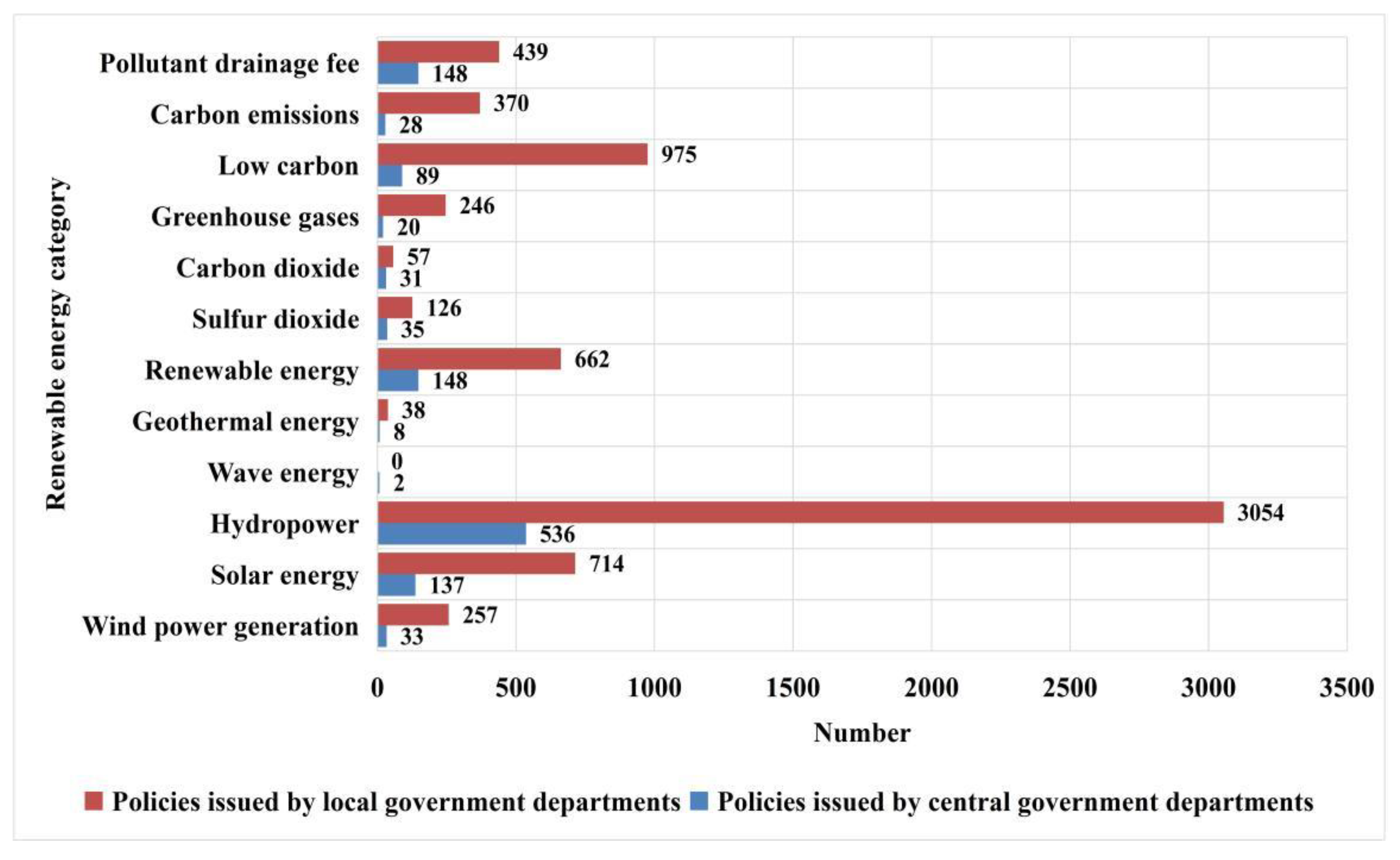
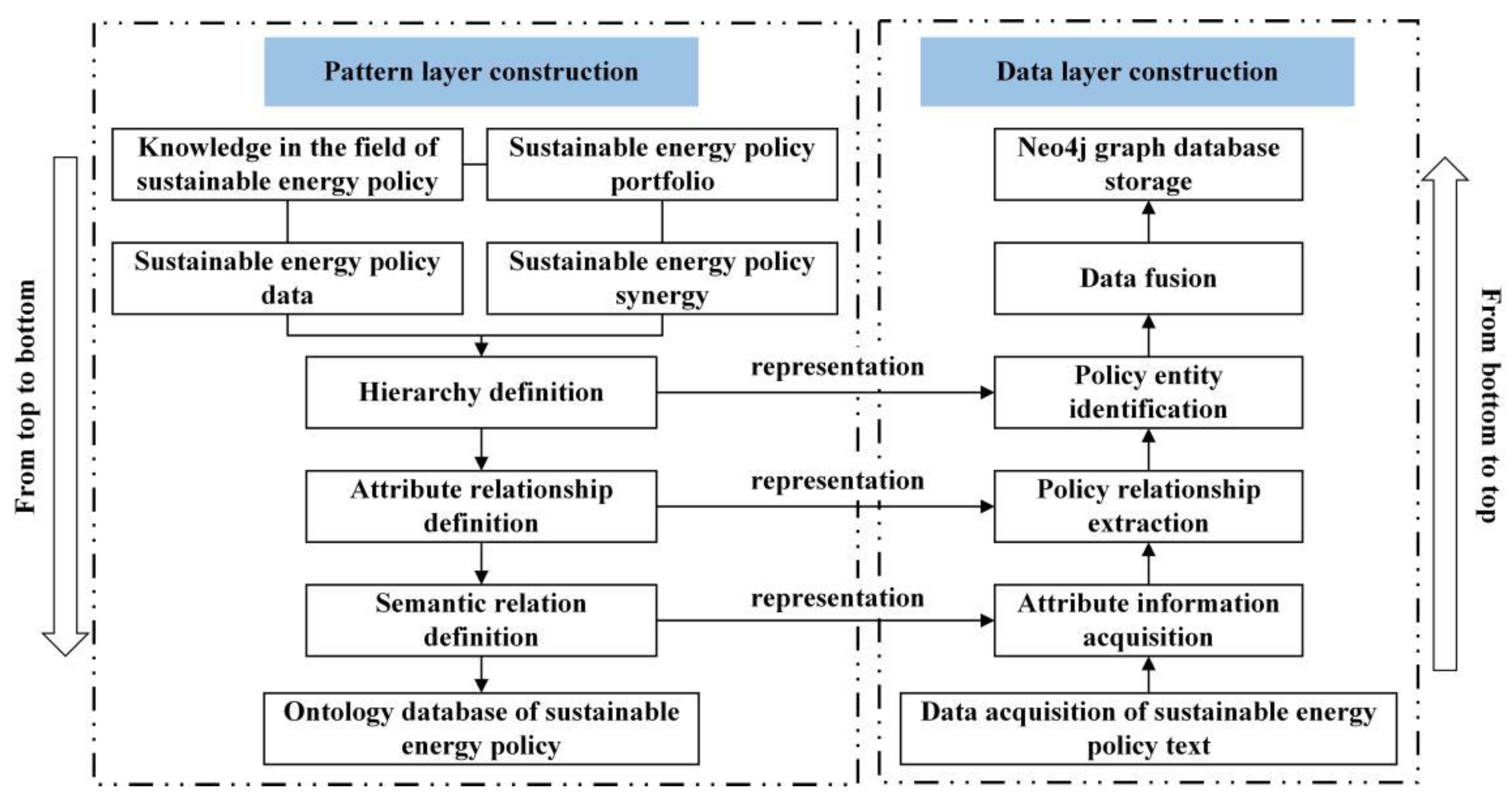
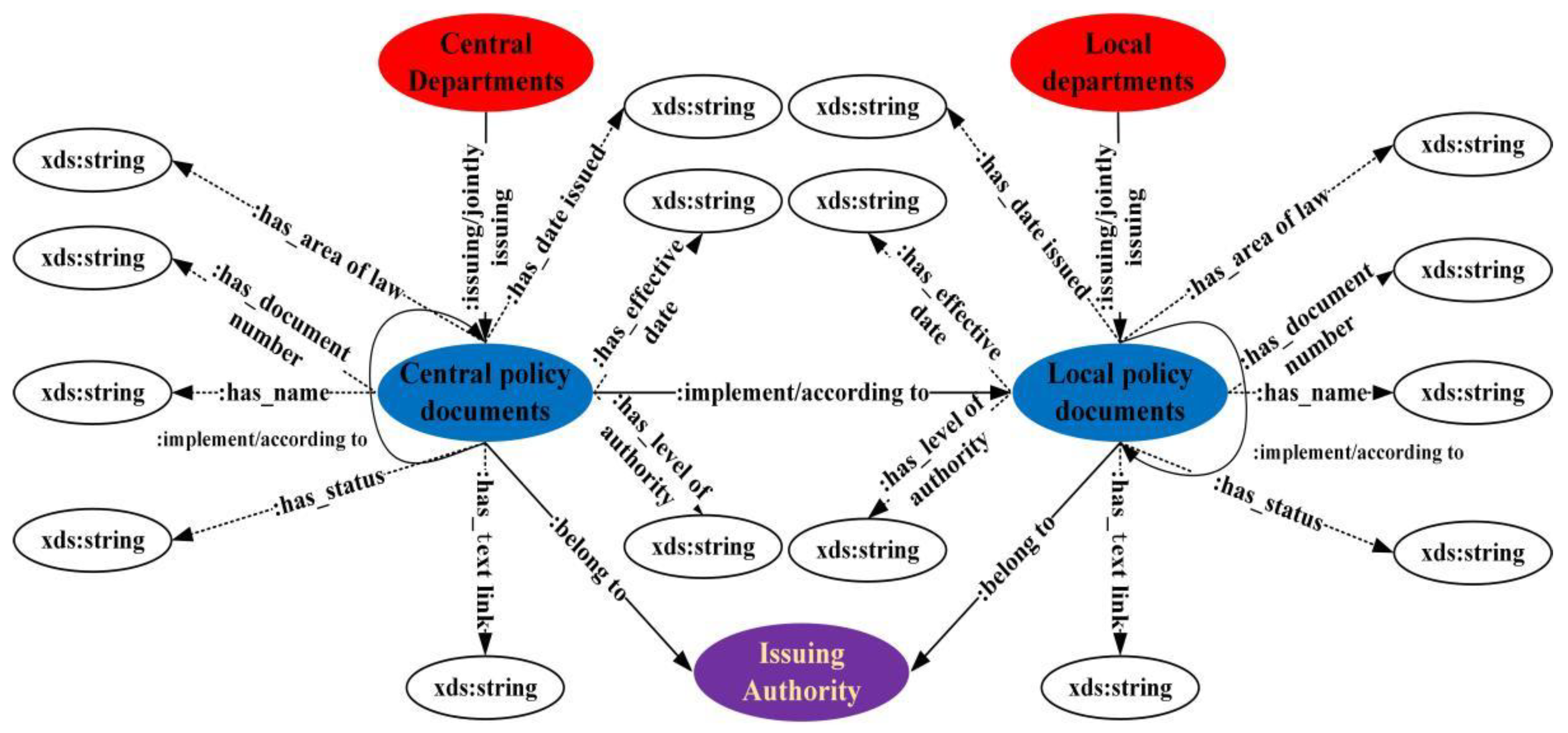
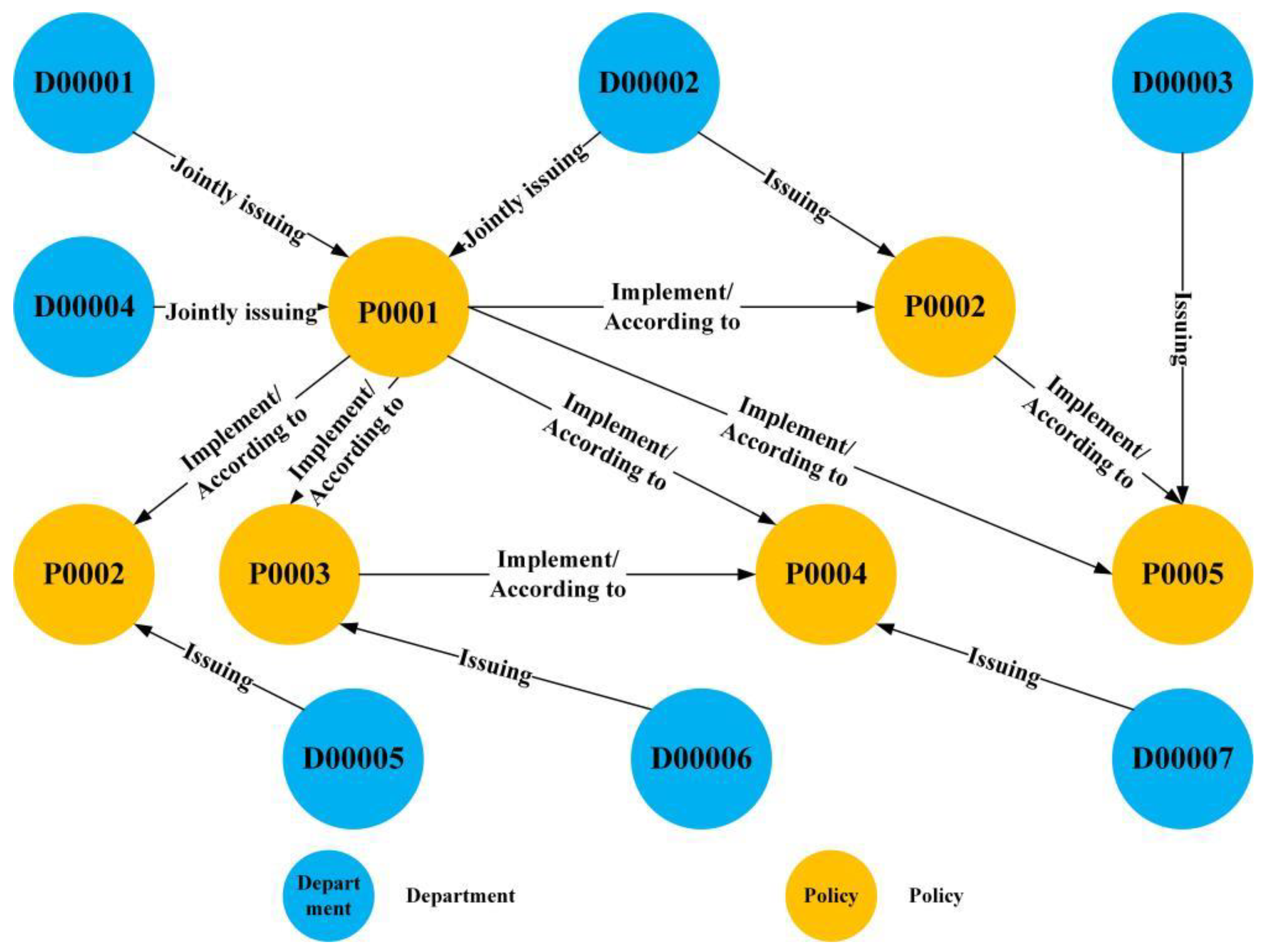
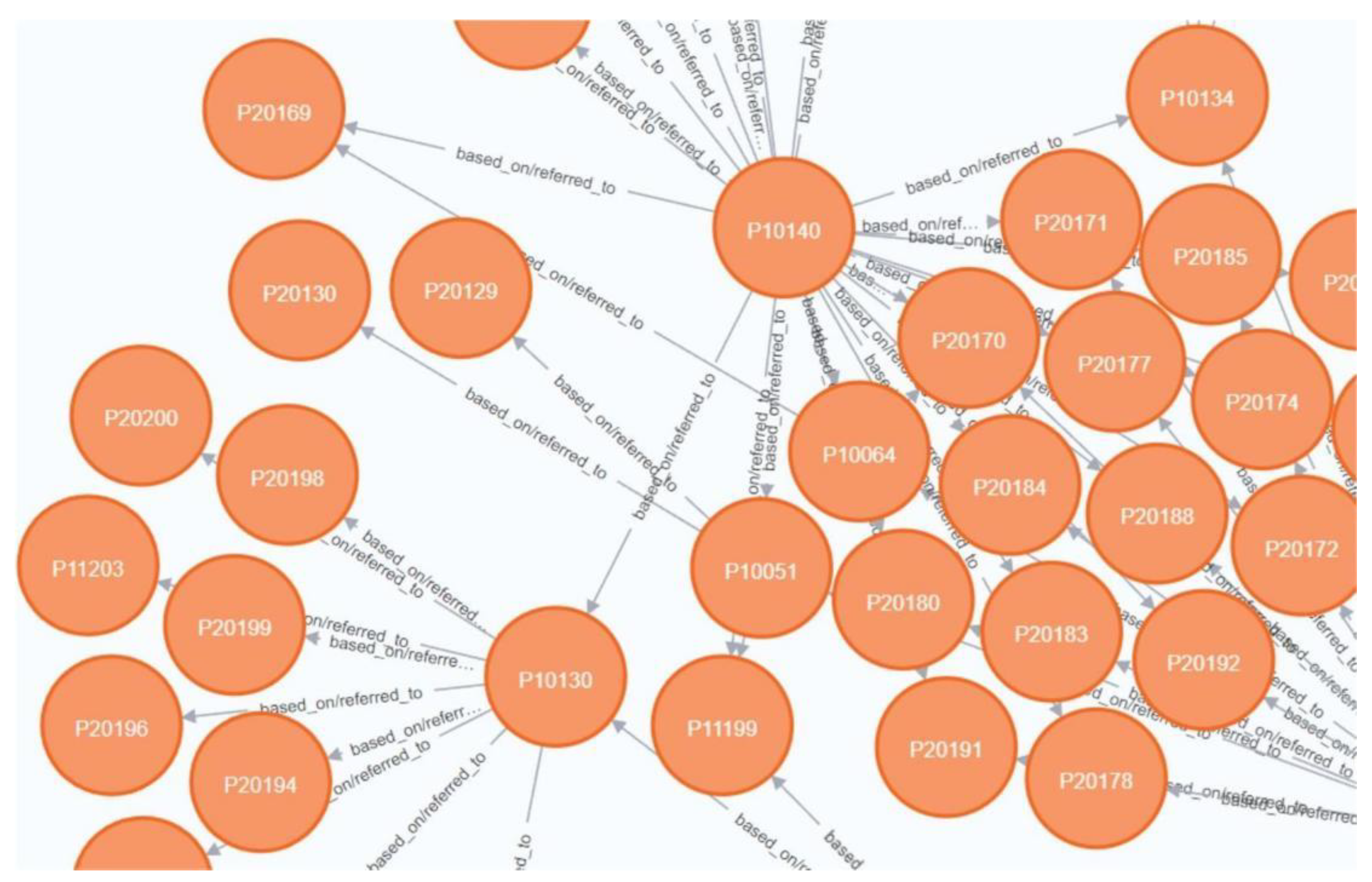
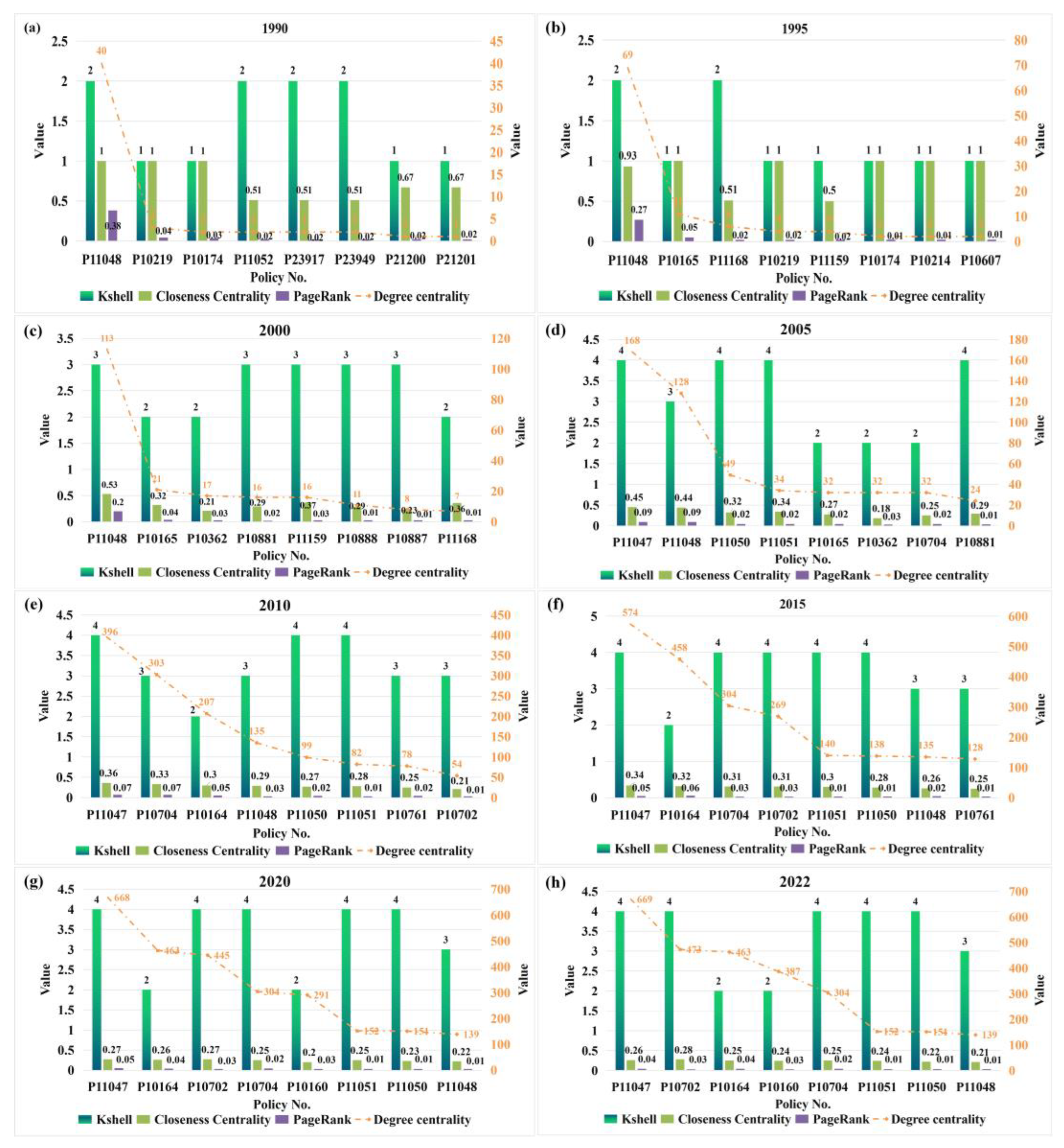

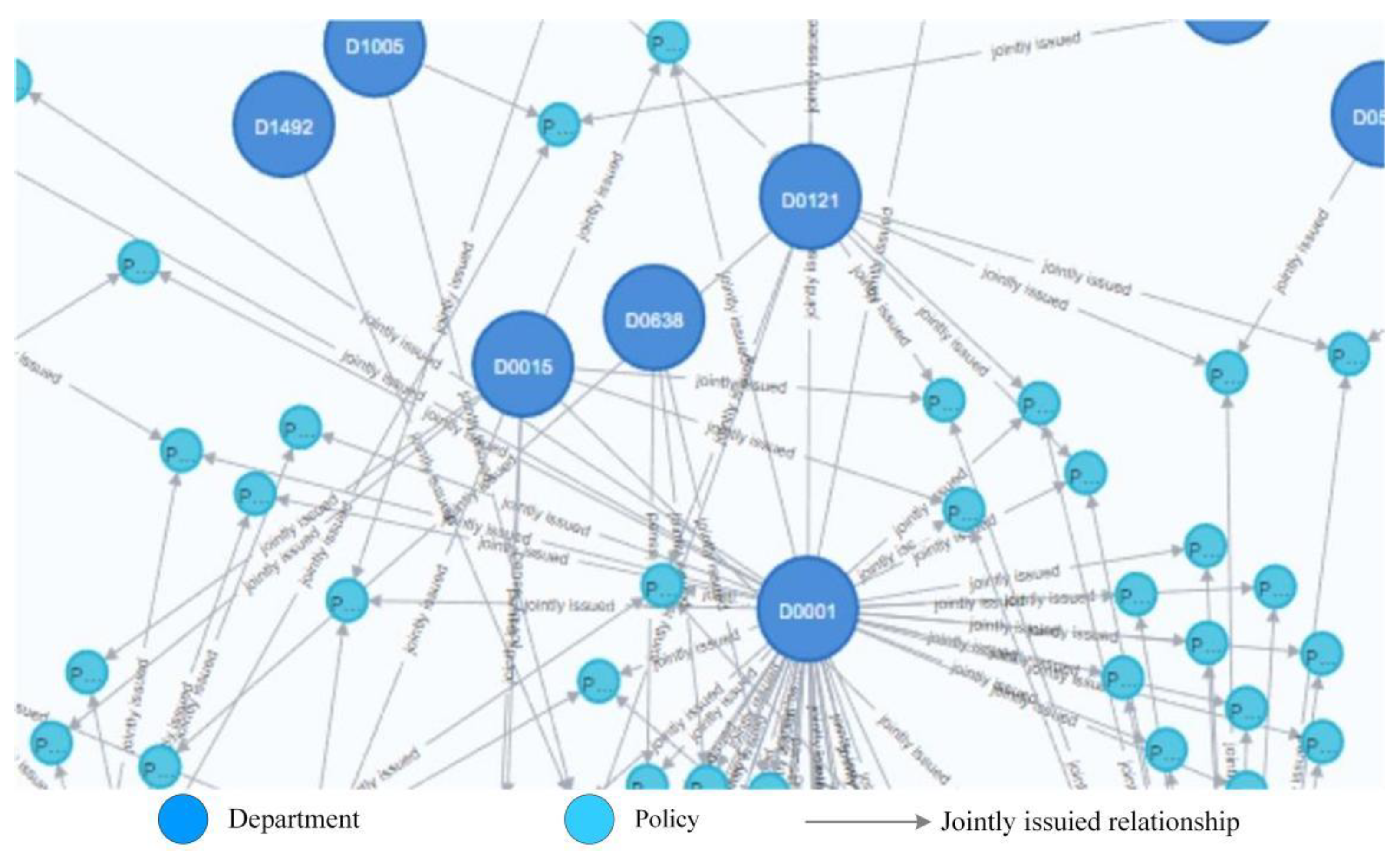
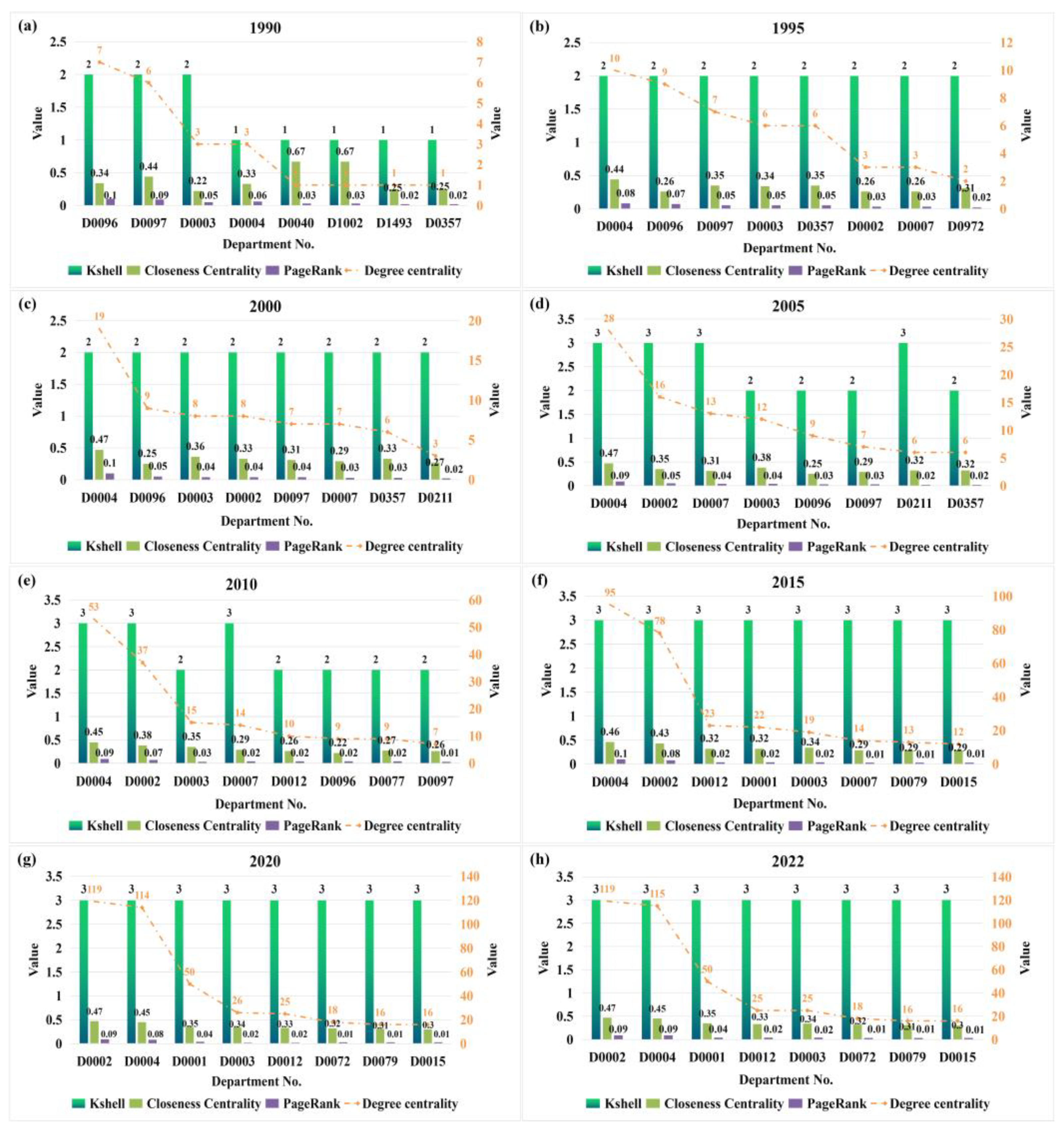
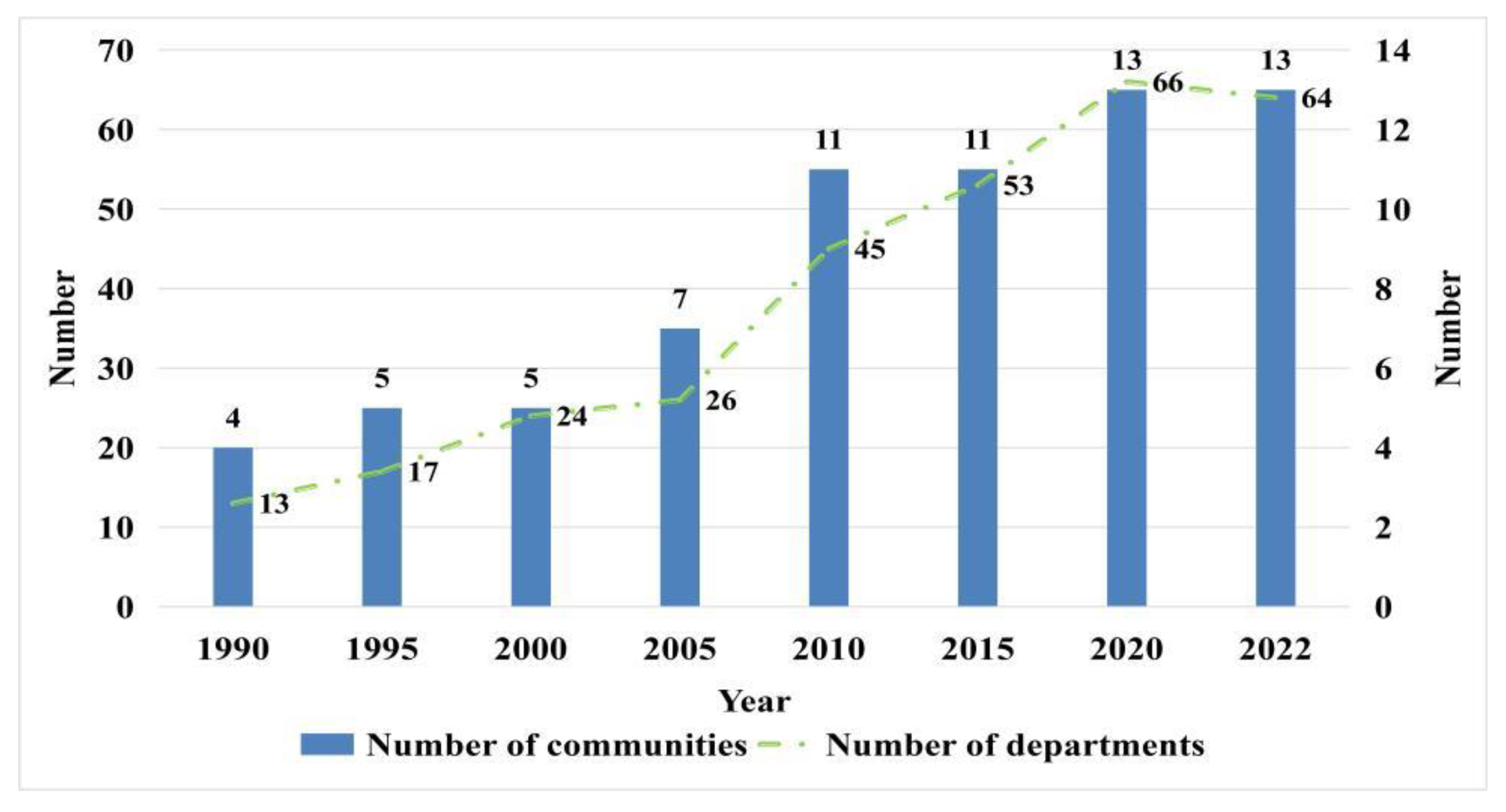
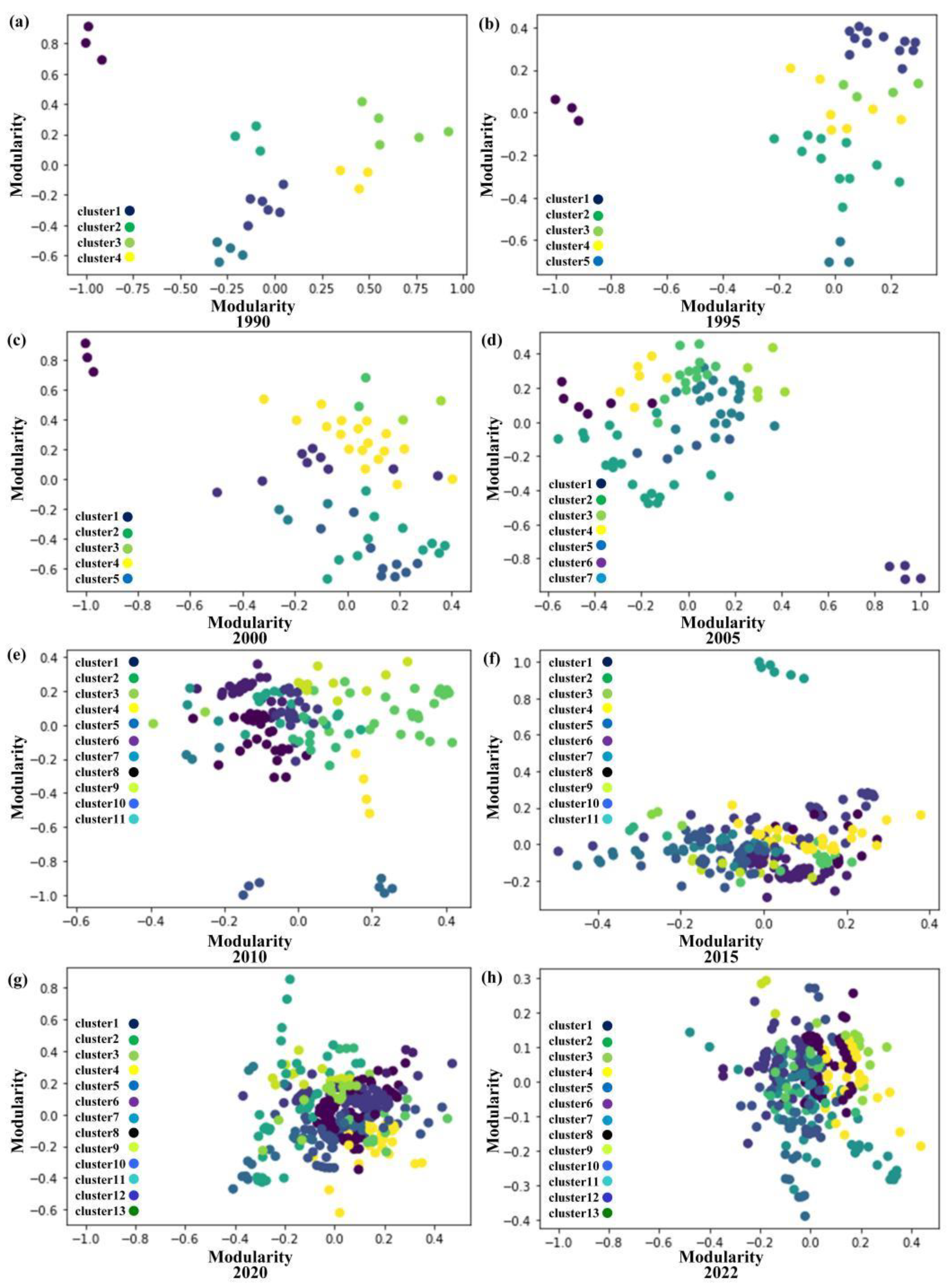
| Effectiveness Level | Quantity | Effectiveness Level | Quantity |
|---|---|---|---|
| Local working paper | 5122 | Administrative regulations | 12 |
| Local normative documents | 2843 | Autonomous regulations and special regulations | 9 |
| Administrative license reply | 995 | Local regulations of cities divided into districts | 8 |
| Departmental working paper | 748 | Inner party laws and regulations | 5 |
| Departmental normative documents | 683 | Documents of judicial interpretation nature | 4 |
| Local government regulations | 139 | Law | 3 |
| Departmental regulations | 71 | Special Economic Zone regulations | 2 |
| Provincial local regulations | 58 | Group regulation | 2 |
| Normative documents of the State Council | 44 | Two high level working documents | 1 |
| Industry regulations | 40 | Local judicial documents | 1 |
| Working paper | 24 | Work reply | 1 |
| Total | 10,815 | ||
| No. | Subject Type | Predicate | Object Type | No. | Subject Type | Predicate | Object Type |
|---|---|---|---|---|---|---|---|
| 1 | Central government | Issuing | Policy | 8 | Policy | Have | Area of Law |
| 2 | Central government | Jointly issuing | Policy | 9 | Policy | Have | Level of Authority |
| 3 | Local government | Issuing | Policy | 10 | Policy | Have | Date Issued |
| 4 | Local government | Jointly issuing | Policy | 11 | Policy | Have | Effective Date |
| 5 | Policy | Implement/ According to | Policy | 12 | Policy | Belong to | Issuing Authority |
| 6 | Policy | Have | Name | 13 | Policy | Have | Status |
| 7 | Policy | Have | Document Number | 14 | Policy | Have | Text link |
| Entity Type | Chinese Meaning | Entity Quantity | Example |
|---|---|---|---|
| Policy | Name of regulations issued by the central government | 10,815 | Environmental protection law of the people’s Republic of China (revised in 2014) |
| Issuing authority | Name of the institution issuing the policy | 1789 | National Energy Administration |
| Level of authority | Policy level | 22 | Departmental working documents, and normative documents |
| Entity Relationship Type | Chinese Meaning | Relationship Quantity | Example |
|---|---|---|---|
| Implement/ According to | Sources of law, legislative authority | 10,808 | <Notice of the National Energy Administration on Matters Related to Reducing the Burden of Enterprises in the Field of Renewable Energy, According to, Renewable Energy Law of the People’s Republic of China> |
| Issuing | Promulgate policies | 10,578 | <Standing Committee of the National People’s Congress, Issuing, Environmental protection law of the people’s Republic of China (revised in 2014)> |
| Jointly issuing | Jointly issuing policies | 683 | <Ministry of Finance, Ministry of Housing and Urban Rural Development, Jointly issuing, Notice of the Ministry of Finance and the Ministry of Housing and Urban Rural Development on Further Promoting the Application of Renewable Energy in Buildings> |
| Belong to | Effectiveness level | 10,815 | <Renewable Energy Law of the People’s Republic of China, Belong to, Law> |
Disclaimer/Publisher’s Note: The statements, opinions and data contained in all publications are solely those of the individual author(s) and contributor(s) and not of MDPI and/or the editor(s). MDPI and/or the editor(s) disclaim responsibility for any injury to people or property resulting from any ideas, methods, instructions or products referred to in the content. |
© 2023 by the authors. Licensee MDPI, Basel, Switzerland. This article is an open access article distributed under the terms and conditions of the Creative Commons Attribution (CC BY) license (https://creativecommons.org/licenses/by/4.0/).
Share and Cite
Sun, Y.; Liu, H.; Gao, Y.; Zheng, M. Research on the Policy Analysis of Sustainable Energy Based on Policy Knowledge Graph Technology—A Case Study in China. Systems 2023, 11, 102. https://doi.org/10.3390/systems11020102
Sun Y, Liu H, Gao Y, Zheng M. Research on the Policy Analysis of Sustainable Energy Based on Policy Knowledge Graph Technology—A Case Study in China. Systems. 2023; 11(2):102. https://doi.org/10.3390/systems11020102
Chicago/Turabian StyleSun, Yuechi, Haiyan Liu, Yu Gao, and Minrui Zheng. 2023. "Research on the Policy Analysis of Sustainable Energy Based on Policy Knowledge Graph Technology—A Case Study in China" Systems 11, no. 2: 102. https://doi.org/10.3390/systems11020102






